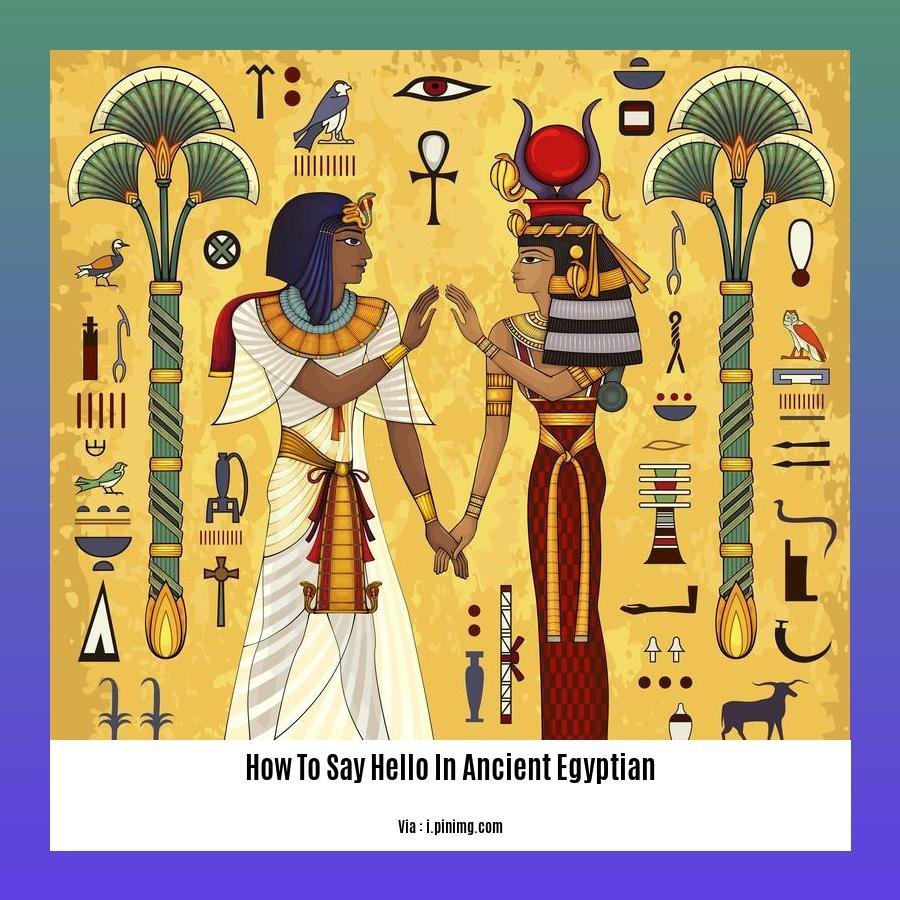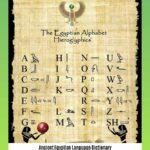Embark on a captivating journey through time as we explore the enigmatic greetings of ancient Egypt in our article, “How to Say Hello in Ancient Egyptian: Unraveling the Greetings of Pharaohs and Hieroglyphs.” Prepare to immerse yourself in the fascinating world of hieroglyphics and unveil the secrets behind the communication of pharaohs and their subjects. Discover the nuances of ancient Egyptian hellos, the cultural significance embedded in each greeting, and the echoes of ancient conversations that continue to resonate across millennia.
Key Takeaways:
In ancient Egyptian, one way of greeting someone was to say “is salām ‘alaykum”.
Another way of greeting someone in ancient Egyptian was to say “alaykum, sal*m’alaykum”.
An appropriate way to respond to “is salām ‘alaykum” was with “wa ‘alaykum is salām”.
To say “welcome” in ancient Egyptian, you could say “ahlan wa sahlan”.
How to Say Hello in Ancient Egyptian

Hello, fellow history enthusiasts! Today, we’re embarking on a journey through time to explore how ancient Egyptians greeted each other. Imagine yourself transported to the bustling streets of Thebes or the majestic temples of Luxor, exchanging pleasantries with pharaohs and scribes alike. Get ready to unravel the secrets of ancient Egyptian greetings and immerse yourself in their fascinating culture.
Unveiling the Ancient Egyptian Language
To understand how to say hello in ancient Egyptian, we must first delve into the intricacies of their language. Ancient Egyptian was a complex and hieroglyph-based script used for over 3,500 years. These intricate symbols, often adorned with images of gods and goddesses, represented sounds, syllables, and even entire words. Deciphering these hieroglyphs has allowed us to uncover a wealth of knowledge about ancient Egyptian culture, including their unique forms of greeting.
Common Greetings in Ancient Egyptian
- “Is Salām ‘Alaykum”
This phrase, which translates to “peace be upon you,” was a common way for ancient Egyptians to greet each other. It conveyed a sense of respect and well-being, wishing the recipient peace and harmony. Imagine yourself entering a crowded marketplace, exchanging this greeting with fellow shoppers and merchants, creating a sense of community and connection.
- “Alaykum, Sal*m’alaykum”
This response, meaning “and peace be upon you too,” was the appropriate way to reply to the greeting “is salām ‘alaykum.” It demonstrated a mutual exchange of respect and well-wishes, fostering a sense of camaraderie and goodwill. Picture two friends meeting at the temple of Amun, greeting each other with these words, acknowledging their shared beliefs and values.
- “Ahlan Wa Sahlan”
Translating to “welcome,” this phrase was used to express a warm welcome to guests or visitors. It conveyed a sense of hospitality and openness, inviting others into one’s home or community. Imagine arriving at a lavish banquet, greeted by the host with these words, feeling welcomed and honored to be part of the celebration.
Beyond Greetings: Nurturing Relationships
In ancient Egyptian culture, greetings were not merely empty words; they were an integral part of building and maintaining relationships. They reflected the values of respect, harmony, and community that were deeply ingrained in their society. Through these greetings, ancient Egyptians acknowledged each other’s presence, expressed their well-wishes, and fostered a sense of belonging.
As we uncover the secrets of ancient Egyptian greetings, we gain a deeper appreciation for their rich culture and traditions. Their words, etched in hieroglyphs on temple walls and papyrus scrolls, continue to resonate across millennia, connecting us to a captivating world of pharaohs, gods, and timeless wisdom.
If you want to learn how to say hello in ancient Egyptian, look no further than this guide that will teach you the basics to get started.
Delve into the ancient world of China to uncover the fascinating secrets of silk production in this article and marvel at the craftsmanship and ingenuity of our ancestors.
Explore the intriguing art of ancient tattooing in this comprehensive piece. Discover how ancient civilizations used unique techniques and tools to create permanent body art.
Contextual Greetings: Unraveling the Greetings of Pharaohs and Hieroglyphs
Greetings in ancient civilizations are a fascinating window into their culture, values, and communication norms. Understanding contextual greetings in ancient Egypt provides valuable insights into the intricate language and rich history of this captivating civilization.
Key Takeaways:
- In ancient Egypt, contextual greetings varied depending on the social status, relationship, and formality of the situation.
- Greetings were often accompanied by gestures, such as bowing or kissing hands, to convey respect and deference.
- Formal greetings were used when addressing superiors or strangers, while informal greetings were used among friends and family.
- The ancient Egyptians used a hieroglyphic script that represented sounds, syllables, and words, making greetings visually stunning and meaningful.
The Nuances of Formal Greetings:
Formal greetings in ancient Egypt were typically elaborate and respectful, reflecting the hierarchical nature of society. When addressing a superior, such as a pharaoh or an official, individuals would often bow or kneel and utter phrases like “Life, health, and prosperity.” These greetings conveyed not just a wish for well-being but also acknowledged the authority and status of the recipient.
The Warmth of Informal Greetings:
In contrast to formal greetings, informal greetings among friends and family were more relaxed and affectionate. Common expressions included “How are things with you?” or “How is your day going?” These greetings demonstrated care and concern for the well-being of the other person, fostering a sense of community and belonging.
The Visual Impact of Hieroglyphics:
Greetings in ancient Egypt were not just words; they were also visual expressions of art and culture. The hieroglyphic script, with its intricate symbols and characters, added a layer of beauty and significance to greetings. Each hieroglyph carried a specific meaning, creating a visually striking and meaningful form of communication.
Sources:
- Ancient Egyptian Greetings & Customs
- Ancient Egyptian Language
Significance of Nonverbal Expressions

We often overlook the crucial role of nonverbal expressions in communication, especially in the historical context. In Ancient Egypt, greetings were accompanied by physical gestures, facial expressions, and eye contact, conveying sentiments beyond words. Let’s explore the significance of nonverbal expressions in ancient Egyptian greetings:
Observing Nonverbal Cues:
- Ancient Egyptians communicated respect through physical gestures like bowing or raising their hand to the forehead.
- These gestures emphasized the reverence and appreciation held for others.
- They also conveyed submission or servitude when greeting superiors or royalty.
Expressing Emotions:
- Facial expressions mirrored emotions like happiness, sorrow, anger, or surprise.
- A genuine smile conveyed warmth and friendliness, while a furrowed brow indicated concern or disapproval.
- These expressions added depth to the spoken words, allowing for a more nuanced exchange.
Establishing Connections:
- Eye contact was a powerful tool for establishing a connection and showing sincerity.
- Maintaining eye contact during a greeting communicated attentiveness and respect.
- Avoiding eye contact, on the other hand, could imply evasiveness or disrespect.
Cultural Context:
- Nonverbal expressions in greetings varied depending on cultural context and social hierarchy.
- For instance, gestures, facial expressions, and eye contact might differ when addressing a pharaoh compared to greeting a fellow farmer.
- Understanding these cultural nuances helps us comprehend the complexities of ancient Egyptian communication.
Universal Language:
- Nonverbal expressions transcended language barriers, allowing people from different linguistic backgrounds to communicate effectively.
- These shared gestures and expressions facilitated interactions and fostered understanding among diverse communities.
Key Takeaways:
– Nonverbal expressions conveyed respect, submission, and emotions in ancient Egyptian greetings.
– Physical gestures, facial expressions, and eye contact added depth and context to verbal communication.
– Eye contact established connections and showed sincerity.
– Nonverbal expressions varied according to cultural context and social hierarchy.
– These shared expressions facilitated communication among diverse communities.
Citations:
– How to Say Hello in Ancient Egyptian
– A Glimpse Into The History Of Hello: An Exploration Of Fancy Words For “Hello” Throughout History
Variations in Greetings Across Time Periods
The ancient Egyptians were a people of great culture and tradition, and their language, hieroglyphics, was incredibly complex and expressive. Their greetings were no exception, and they varied greatly depending on the time period, social status, and relationship between the speakers.
Key Takeaways:
- Formal and Informal Greetings:
- Formal greetings were used in ceremonial settings and towards superiors.
Informal greetings were used among friends and family.
Social Status:
- The social status of the speaker and the recipient influenced the greeting used.
Greetings were often tailored to show respect and deference to those of higher status.
Time of Day:
- Greetings varied depending on the time of day.
Specific phrases were used for morning, afternoon, evening, and night.
Titles:
- Titles were often used in formal greetings.
Titles indicated the speaker’s social status or position.
Physical Gestures:
- Physical gestures, such as bowing or raising one’s hand, often accompanied greetings.
These gestures conveyed additional meaning and respect.
Nonverbal Communication:
- Facial expressions and eye contact also played a significant role in greetings.
Nonverbal cues could convey additional emotions or intentions.
Regional Differences:
- Greetings could vary regionally within ancient Egypt.
- Different regions had their own unique customs and traditions.
Conclusion:
The nuances of ancient Egyptian greetings offer a fascinating glimpse into their culture and society. Their greetings were a reflection of their values, beliefs, and social hierarchy. Understanding these variations can help us better appreciate the richness and complexity of ancient Egyptian civilization.
Sources:
- Ancient Egyptian Language and Greetings
- Greetings in Ancient Egypt
FAQ
Q1: How did ancient Egyptians greet each other?
A1: Ancient Egyptians used various greetings depending on the time of day and social context. Common greetings included “Good morning” (Renpet utja), “Good afternoon” (Mesut utja), and “Good evening” (Ipet utja). Additionally, phrases like “How are you?” (Setut enekh?) and “May your day be happy” (Njub ef rek enekh) were also used.
Q2: Were there any specific greetings reserved for royalty or other high-ranking individuals?
A2: Yes, formal greetings were typically used when addressing important individuals. In ancient times, salutations were generally quite formal, with specific phrases used in different cultures. For example, in ancient Egyptian culture, phrases like “May your life be long and prosperous” were commonly used when greeting royalty or high-ranking officials.
Q3: Did ancient Egyptians use physical gestures to accompany their greetings?
A3: Yes, greetings were often accompanied by physical gestures, such as bowing or raising one’s hand to the forehead. Nonverbal communication, such as facial expressions and eye contact, also played a significant role in conveying additional meaning in greetings. These gestures and expressions added depth and nuance to the spoken words, enhancing the communication and connection between individuals.
Q4: What was the significance of greetings in ancient Egyptian culture?
A4: Greetings were not only used to convey politeness and respect but also to establish and maintain social bonds within Ancient Egyptian society. By exchanging greetings, individuals acknowledged each other’s presence, showed mutual respect, and expressed positive sentiments. This exchange of greetings helped strengthen relationships, foster community, and create a sense of belonging among the members of ancient Egyptian society.
Q5: Are there any remnants of ancient Egyptian greetings still used in modern-day Egypt?
A5: Yes, some remnants of ancient Egyptian greetings can still be found in modern-day Egypt. For example, the Arabic phrase “As-salaam alaykum” (Peace be upon you) has roots in the ancient Egyptian greeting “Saalamoekom” (Peace on you). This phrase is commonly used as a greeting in Egypt and other Arabic-speaking countries, demonstrating the enduring legacy of ancient Egyptian culture and language in the region.












